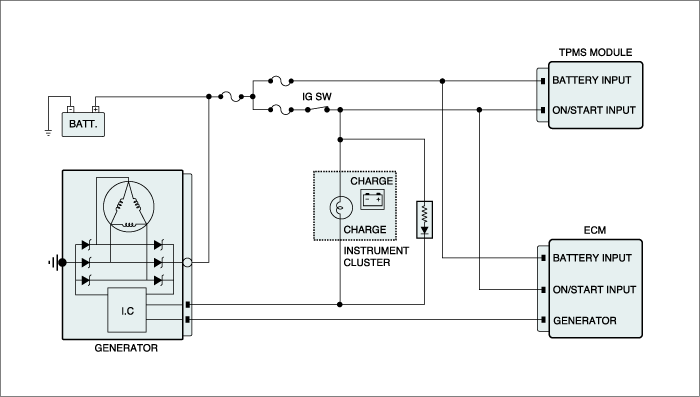Is 'C1661' present ?

▶ Substitute with a known-good TPMS Receiver module and check for proper operation.
▶ If the problem is corrected, replace TPMS Receiver module and go to "Verification of vehicle Repair" procedure.

▶ System is OK.

TPM Receiver
TPM Receiver is integrated with the TPM module installed in the back side of center console. The operating battery of TPM module is supplied from the vehicle battery.
A HIGH-LINE TPMS Receiver performs the same functions as the LOW-LINE RX, but in addition is equipped to control three Low Frequency Initiator (LFI) devices, fitted to the vehicle near each of the three tire locations. When the ignition circuit is first energized, the TPMS Receiver unit activates each of the LFI devices one at a time. The coded electromagnetic field from the LFI device causes a nearby WE to temporarily suspend normal processing and broadcast an RF message. The message content is the same as those normally generated by the WE sensor, with the exception that the operating state information within the broadcast reflects that the WE has detected the coded electromagnetic field from a nearby LFI device.
Upon reception of the broadcast from the WE sensor, the TPMS receiver is able to associate the unique WE ID code with the wheel’s position on the vehicle, due to the known location of the LFI units. This “auto-location” process takes place each time the vehicle’s ignition circuit is energized and vhhicle speed is more than 25km/h after parked for 19min, so that changes in wheel position will be noted. The TPMS Warning Algorithm continues to evaluate the pressure and temperature of each tire, and is responsible for making the decision to alert the driver to a potentially dangerous tire inflation condition via a visible ‘TREAD’ indicator. It also indicate the appropriate tire position via a ‘FR’ (Front Right), ‘FL’ (Front Left), ‘RR’ (Rear Right), or ‘RL’ (Rear Left) indicator
This DTC indicates that the receiver has a problem reading or writing to EEPROM. The most likely cause is TPMS Receiver failure.
Item | Detecting Condition | Possible cause |
DTC strategy | ● Check Receiver module | ● Faulty TPMS Receiver |
Enable conditions | ● IGN ON | |
Threshold value | ● Writing in the EEPROM was unsuccessful. | |
Mil On conditon | ● Active DTC is set |
Set up 'GDS' with 'GDS TPMS'.
Select the "TPMS" system.
Execute "DTC Analysis" mode and clear DTC.
Check the present DTC.
Is 'C1661' present ?

▶ Substitute with a known-good TPMS Receiver module and check for proper operation.
▶ If the problem is corrected, replace TPMS Receiver module and go to "Verification of vehicle Repair" procedure.

▶ System is OK.
After a repair, it is essential to verify that the fault has been corrected.
Connect TPMS exciter or scantool and select "Diagnostic Trouble Codes(DTCs)" mode
Using a TPMS exciter or scantool, Clear DTC.
Operate the vehicle within DTC Enable conditions in General information.
Are any DTCs present ?

▶ Go to the applicable troubleshooting procedure.

▶ System performing to specification at this time.
